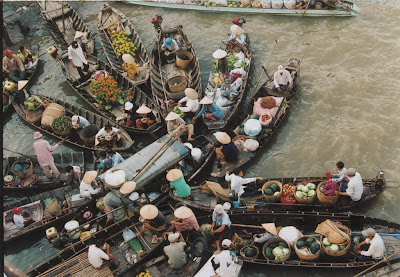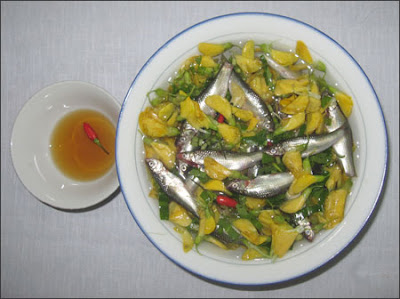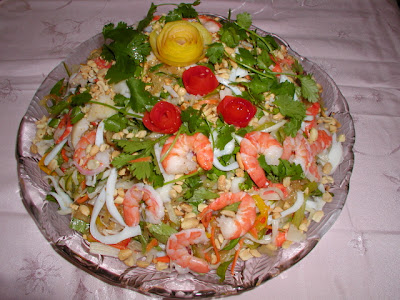 |
| Mekong delta map |
Situated in the lower section of the legendary Mekong River, the Mekong Delta (known as the Nine Dragon River Delta in Vietnam), Southern of Vietnam, covers 40,000 square kilometers and houses 17.5 million people. Embracing 13 provinces and cities, the Mekong Delta borders HCM City in the north, and the Gulf of Thailand and Cambodia in the west. The East, South and Southwest are encompassed by sea with a length of more than 700km.
 |
| Can Tho bridge is under construction |
 |
| Floating market |
The Mekong Delta has distinct advantages over other regions in Vietnam. That is mild weather (average 28 degrees Celsius), high sunshine intensity (2,226 – 2,709 hours of sunlight per year) and less vulnerability to natural disasters. The Mekong Delta currently is the colossal granary of all Vietnam, annually accounting for over 50% of the nation’s rice production, 90% rice export, 65% seafood production and 70% fruit production, making it one of the three largest economic areas of Vietnam.
Originating in snow-capped mountains of the Tibetan Plateau, the 4,200 km-long Mekong River has two tributaries running through the Southern plains which are called Tien River and Hau River. The lower Mekong River region belonging to Vietnam has more than 1,200 species of fish, including over 60 species with economic value focusing on the carp family (Cyprinidae) and the giant catfish family (Pangasiidae), with an estimated output of 2 million tons/year. The Mekong River annually discharges into the region over 460 billion cubic meters of water, carrying some 150 – 200 million tons of silt which are 7 – 8 times than that of Hong River in the North. That makes this delta more fertile and affluent.
The Mekong Delta is famous for its boundless rivers and interlacing canals. Over 700 km of seashores, some 28,000 km of rivers, thousands of km of canals, hundreds of green islets floating on the water and nine estuaries like nine mouths of the dragon keeping on impetuously pouring water into the sea make it convenient for rowboat-combined-with-pleasure boat tours penetrating deep to the canals system…
Floating market (namely Nga Bay, Phung Hiep – Hau Giang, Cai Rang, Phong Dien – Can Tho,
Cai Be – Tien Giang…) that have come into being for a hundred years are regarded as “the spiritual element”, the advancement of the Southern river civilization. A lively atmosphere is created by convoys of boats fully loaded with countryside products gathering in one locality, thousands of “bẹo” (a long bamboo pole set up on the boat used to hang up samples of what it sells) dangled high above the boat bow, inviting fellow traders even before the sun has emerged. Both buyers and sellers move by boat in the middle of the immense river. That countryside life picture is so specific to the South of Vietnam. There is even a “boat culture” diversified with sampans, wooden barges, junks and many kinds of fishing boats in different sizes and shapes.
The Mekong River Delta becomes more pristine, natural and lively at the arrival of flood season. The first spell of the flood occurs around June to July, the crest of flood comes in September or October but flood waters gradually rise. The flood season arrives. Stretching as far as the eye can see, submerged rice paddies look dazzling white against brilliant yellow of blossoming “điên điển” flowers. From the distance appear fishmen on small boats placidly dropping their lines, casting their nets…
The Mekong River Delta’s countryside and its horticulture methods have been evidenced by more than 2.000 rice species. Over 130 year ago, Go Cong round grain rice or Vinh Long long grain had represented Vietnam’s rices to become the first one exported to the West. Cai Mon, Cho Lach situated in the three large islands called An, Bao, Minh of Ben Tre province have been noted for fruit – tree grafting. Bonsai gardens and especially fantastic ornamental plants grown in the shape of animal designations associated with lunar years like rat, ox, tiger, dragon… are regarded as one of the special creations of the delta’s countryside. The artists develop their own grafting and shaping techniques which are distinguished from those of the Chinese, the Midland or the North.
The Mekong Delta boats the land of biodiversity and rich produce. Taking a boat ride throughout the 700,000-ha Dong Thap Muoi, one will discover the wildly inundated low-lying area or explore Ca Mau mangrove forests which ecological system is similar to that of the Amazon estuary, and extensive U Minh cajeput forest. Being “Dat lanh chim dau” (good earth, bird land), the Mekong Delta is home to a great number of bird species, particularly migrating ones. 7 large breeding sanctuaries of herons, striped storks, egrets and bitterns have been discovered. Phuong Dong red-beaked cranes get together in Tam Nong – Dong Thap. Tram Chim Reserve has 92 known species of birds while U Minh forest is home to 81 species and dozens of bird sanctuaries where thousands of birds glide through a blue sky as the sunset comes.
Ba Dong Sea (Tra Vinh), Khai Long Sea (Ca Mau)… which boast magnificient natural beauty are flooded with sunlight all year round. Ha Tien sea, especially Phu Quoc (Kien Giang), the Vietnam’s largest island sited in the Gulf of Thailand are a special favour which the Creator specifically dedicates for the heavily silted Mekong delta.
The Mekong Delta is a place of converging and exchanging cultures of 4 ethnic groups: Viet, Khmer, Chinese and Cham, taking the place of the vanished Oc Eo culture as well as bearing the hallmark of the ancient Kingdom of Funan (Phu Nam in Vietnamese) which was once celebrated. Therefore, it is fascinating to arrange culture, custom, belief exploring tours. The life of local people is not confined to their village’s bamboo hedges but a wide open space, stretching along rivers and canals. That helps create their nature which is honest, open-minded, moral, hospitable, “tu hai giai huynh de” (within the four seas all men are brothers).
Vong co (a special style of singing using the whole breath without any break), cai luong (reformed drama) are unique traditional art forms which are so specific and only exist in the South of Vietnam. Despite over 80 years passed, the song entitled “Da co hoai lang” (yearning for one’s husband upon hearing midnight drumbeats) still win the audience’s heart because of its noble humane nature: “Tu la tu phu tuong/ Bao kiem sac phong len dang/ Vao ra luong trong tin chang/ Nam canh mo mang/ Em luong trong tin chang/ Oi gan vang quan dau” (Ever since you received the call/ Took on your duty in war/ I keep walking back and forth, awaiting your news/ Staying awake throughout the night/ I have been longed for your news/ How painfully my heart throbs).
A long with ancient Vietnamese communal houses are Chinese temples and pagodas. The magnificent Islamic mosque (known as Mubarak mosque) for the Cham minority community with its graceful onion-shaped dome stands reposefully along the Chau Giang River. The theravada-Khmer pagoda roofs are colorfully striking and sharp-pointed curved with images of the Krud Garuda mythical bird and the Naga snake engraved in a highly sophisticated way. Con Phung (Phoenix islet) in Ben Tre is the “holy land” of Dao Dua (Coconuts) featuring a court decorated with 9 dragon-carved pillars and a tower; Tay An ancient pagoda situated in the mysterious That Son mountain range (An Giang) is a worship place of the founder of Buu Son Ky Huong religion… Noted among hundreds of ancient houses standing along the Mekong is a 130-year-old house with five compartments and two rooves in Binh Thuy (Can Tho).
The Mekong Delta is the land of festival as well. Thanh Minh (grave-sweeping) festival, in which people pays respects at their ancestors’ tombs, entices both the Vietnamese and Chinese. Cham people are proud of Hadji Festival, Ramadan. The Khmer community is jubilant with fine-toned music during festivals of Chol Chnam Thmay (New year), Dolta (Amnesty for the dead), Ok Om bok (Moon Prayer). There are also Via Ba Chua Xu (the birth anniversary of the local tutelary goddess) festival, Bay Nui (seven mountains) ox racing festival (An Giang), Nghi Ong (welcoming the whale) festival in coastal areas… The ancestors’ cultural identity has been preserved by hundreds of craft villages. An Giang has the brocade weaving village of Cham and Khmer people, the 100-year-old floating house village. Phu Quoc is most celebrated with nuoc mam (fish sauce) made with anchovies, peppers. Soc Trang boasts its mat craft. Go Den – Long An alcohol made with sticky rice has been renowned nationwide. There are also rice papers of Luong Hoa (Tra Vinh), the boat building village of Nga Bay (Hau Giang), the fishing net hamlet of Thom Rom, the bamboo fish trap of Thoi Long (Can Tho)…
 |
| It was used to be a famous place |
Lau mam (salted fish hot pot) of Chau Doc, the fascinating delicacy of the Southern land, cannot be called excellent if not accompanied by two dozens of several fresh vegetables and aromatic herbs like cu neo, tai tuong, cang cua, so dua flower, dien dien flower,… Thit kho nuoc dua (braised pork in coconut juice), can chua ca loc (snake head sour soup), ca loc nuong trui (grilled-straw snakehead fish), ran nuong leo (plain baked snake), mam kho (preserved salted fish stew), chuot dong ro ti (roasted field mouse in coconut juice), luon hap trai bau (eel steamed with gourd), ca ro kho to (anabas braised in bowl), ca bong dua kho tieu (sand goby simmered in pepper sauce), hu tieu My Tho (My Tho – styled noodle soup), tom lui Bac Lieu (Bac Lieu – styled shrimps roasted in stick), nam tram (boletus) Phu Quoc, Tunglomo (beef sausage blended with cold rice), Hapaychal pastry (Khmer people), canh Sim lo (banana flower soup cooked with fried salted fish), bun nuoc leo (rice noodle in snakehead fish, shrimp, pork, lemon grass broth), mam (salted fish) Prahoc (Khmer people)… and many other delicacies make the delta’s beauty more charming, pervasive, and unforgettable to tourists.




































